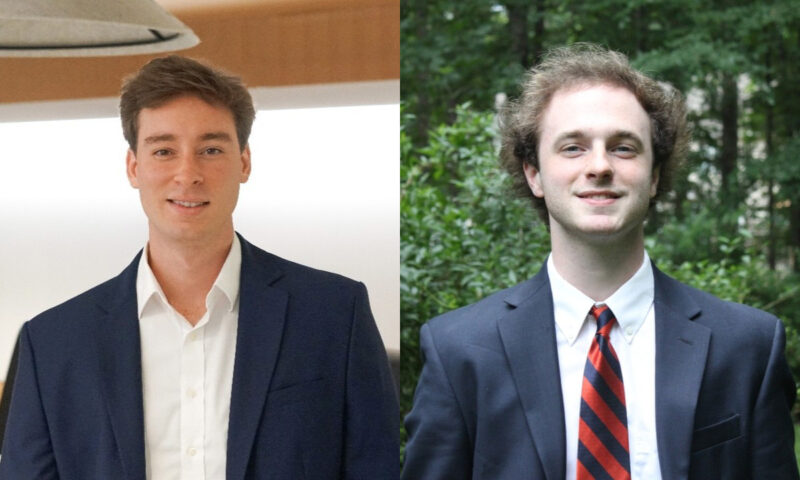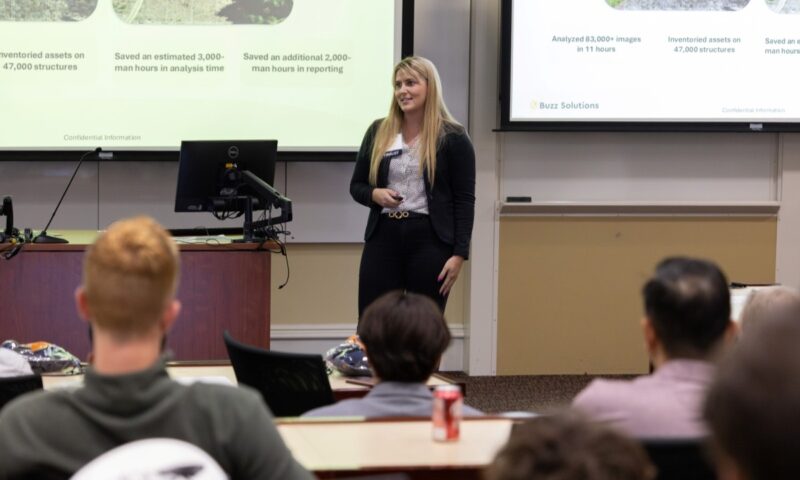If the exchange of ideas and shared discovery of scholarly interests are what focus the efforts of UVA’s Center for Real Estate and the Built Environment, it is the people, their insights, and their experiences that are strengthening the Center in its mission to enhance our world and the impact of real estate on our lives.
To enhance understanding of the subject, we reached out to collect important insights of four standout alumni figures who are making strides in the real estate profession as they add to and protect the integrity of the built environment.
Tracey Brownfield (McIntire ’79) is Owner and President of Land Veritas, which establishes wetland mitigation banks and whose projects will ultimately conserve nearly 5,000 acres in California. The company supports the built environment by providing customers such as public agencies, utilities, and developers with compensatory mitigation for projects that have unavoidable impacts to wetlands or sensitive habitats.
Senior Managing Director with Blackstone Rob Harper (McIntire ’00) oversees asset management for the company’s real estate business in the Americas. As he and his company buy, sell, renovate, and in some cases, develop assets from the ground up, they are constantly gathering data to help execute on their investment objectives.
Scott Kelley (McIntire ’83) has served as the Founder and CEO of Aetos Capital Real Estate since 2001. Though his firm primarily invests in properties in Asia, it has also become affiliated with a group doing opportunity zone developments and distressed investing in the Washington, DC, area and Southern Florida. He believes that building new environmentally sensitive products will be key to future success.
Founder and Co-Managing Partner of strategic real estate consulting and advisory firm 9th Green Advisors, Earl Webb (McIntire ’78), spent his early career in investment banking, before pivoting to commercial real estate, where he has spent the bulk of his career in transactional as well as managerial positions. He notes that he has benefited from working closely with people he calls some of the most creative, experienced, and successful real estate professionals throughout the world.
We spoke to Brownfield, Harper, Kelley, and Webb about their work, challenges, opportunities, connections to their UVA education, and guidance for current students considering one of the many careers in the vast field of real estate-related professions.
Points of Interest, Points of Friction
Each of the University alums is enthusiastic about disparate elements of their profession, showing the wide range of spaces within the greater real estate and built environment areas.
Brownfield, who pivoted from being a developer 15 years ago, uses her real estate skills to restore and conserve land. “My work is exciting to me because it is creative, innovative, and allows me to combine my work with my philanthropic interests,” she says. “But the best part is spending a lot of working hours in nature.”
Harper enjoys working with Blackstone’s broad and diverse portfolio that includes “logistics assets, residential properties, hotels (including limited services hotels like Extended Stay America), offices, and data centers.” The significant exposure of the portfolio creates a diversity of experiences on a daily basis, and he’ll be the first to admit that the varied property types “keeps things interesting,” as the large scale of his business provides an unprecedented macro view and level of freedom to undertake initiatives that others might not be able to approach within the real estate investment sphere.
Kelley is animated by what he predicts to be a host of inviting real estate investment possibilities in the coming years. “A lot of people became addicted to free money, and the lenders were very lightly regulated; the combination of those two factors have many groups overleveraged at a time that we’re going into a recession, so I think there’s going to be some really terrific investment opportunities.”
For Webb, it comes down to collaboration. “The most exciting thing about my business and career is the various people I have had the pleasure of working with,” he says. “To be able to share in the experience of value creation in real estate, from a project’s creation to fulfillment, has been terrific. Helping people, partnerships, and companies solve complex real estate issues has been extraordinary.”
Regarding the current landscape, Webb notes that a number of sectors of real estate are in a dramatic state of flux, with office, retail, and hospitality real estate experiencing drastic changes in their usage and, concurrently, in their values and investment returns. “Residential and industrial real estate have weathered the demographic and COVID-driven changes better, but still face demand movements and social/environmental mandates for changes to structure and aesthetics,” he says, explaining that the rapid pace of both financial and societal changes is proving difficult for real estate to adapt to, given that the asset is traditionally defined by its long lead time.
Kelley sees real estate as an inherently cyclical business, and like Webb, believes office buildings and retail will continue to be impacted in a disproportionate way. “They have a lot of challenges, and I think they’re going to continue to have a lot of challenges,” he says. “Institutional capital, therefore, has wanted to invest in logistics and residential. I think we’re going to be modestly overbuilt on the logistics side, while the residential side continues to be somewhat underserved. We’re seeing a massive population shift away from high-tax, high-crime, expensive states and cities, and so you’ve got to be in the right markets and submarkets. It continues to be a very local business.”
For Harper, two challenges come to mind: interest rates and the role of ESG in real estate.
“The recent rise in interest rates has an impact on financing ability and costs, impacting cap rates and valuation. For many people investing today, this higher interest rate environment is not something that they’ve lived through before,” Harper says. “The increasing focus on all things ESG, energy consumption, and other aspects of building and owning real estate assets has also become significant. I think that’s just going to increase over time, impacting real estate investors, operators, and companies going forward.”
Webb also believes that the emphasis on ESG and its real estate-related impacts is interesting, in both positive and negative ways. “Environmental impact of real estate is huge, and improving building energy efficiency, reducing carbon footprint, and providing work-life space are immensely important,” he says.
Kelley believes that a critical long-term question concerns the role of China and India in the global economy for a host of reasons, but notably within the context of the health of the planet. “When people talk about the impact on the environment, if you don’t get China and India and their urbanization plans somehow committed to trying to reduce carbon emissions, the rest of it doesn’t matter. Those are ecological imperatives that we talk about,” he says.
That environmental aspect is the biggest challenge for Brownfield, who is squarely focused on conservation, not development. “From my perspective we need to create denser urban areas and conserve more open space. Per the EPA, one in three Americans gets their drinking water from streams protected by the Clean Water Act (1972), so wetland protections, and the resulting water quality improvements, must be kept in place and not weakened to accommodate the built environment,” she says. “The same is true for species’ habitats, as prioritized in the Endangered Species Act (1973). In California, we have already filled over 90% of the original wetlands. How do we balance environmental priorities with development? That is the challenge.”
Inventive Openings in Real Estate
Brownfield believes that while providing a robust built environment, addressing climate change, and protecting ecosystems are major challenges and ripe for innovation, she finds that the “younger generation’s growing concern about the health of the planet is encouraging—and hopefully a wake-up call for our generation. It is possible to have a robust built environment and continued economic growth while addressing climate change and ecosystems’ degradation; it is not a zero-sum game.”
While Harper points out innovation across his company’s portfolio, in such areas as lab-office buildings and medical research, data centers, warehouse good processing and distribution, as well as robotics in real estate, these days his attention is drawn indoors—specifically, regarding the office.
“We can talk about people who are or are not going into the office in today’s world, but we are a work-from-work type of company. We come in and we collaborate, so for our company, being together in an office building and in a professional environment is where we spend time and innovate,” he says. “What’s happening in the office sector today I think is actually the most interesting thing going on in the real estate space. Who’s going to the office, who’s not going into the office, and how does that impact people professionally and personally with more flexibility to pursue a better work-life balance in a post-COVID world? But also balancing how to be productive at work. Do people return to the office rapidly? Slowly? Different types of industries and different types of geographies. And then the impact on what is this office building worth, what type of office building does somebody want to be in moving forward versus the historical standard?”
Office space is also of interest to Webb, who predicts a substantial change in the way people occupy work areas. “It will continue to demand new exterior and interior design to accommodate a more flexible work environment,” he says. “Additionally, as the occupancy population moves to a younger cohort, the importance of climate change, workplace flexibility, work-live-play, and other factors will become higher priorities than perhaps they have been in the past. Commuting patterns are changing, requiring more amenities and home/work proximity. Big data can also streamline the analytics behind real estate investment, development, and occupancy decisions and help investors and occupiers make better financial decisions.”
Harper also says that developing new housing offers a great many avenues for innovation to reverse the lack of supply that has defined the U.S. market for a lengthy period of time characterized by rising rents and home prices. “Parts of the construction industry are antiquated, and there are likely to be opportunities to add efficiency through technology. There are a number of companies working to deliver housing more resourcefully through technology and data to enhance and modernize the process. It is possible that some may make some innovative leaps to make housing faster and at a more efficient cost.”
Kelley references his work as Chairman of PTM Partners, which built a residential building in Overton, a historically Black area of Miami. “The idea was to downsize the units a bit but increase the amenities to basically condominium quality,” he says, explaining that it was a winning strategy for everyone involved. “Increasingly, younger tenants are going to be looking for heavily amenitized buildings, so I think that’s the way of the future.”
Learning for a Professional Life and More
Harper explains that in addition to getting a solid financial education that gave him the skills to evaluate assets, his time at UVA provided career connections, crediting his McIntire coursework with securing him a real estate-related internship between his third and fourth years. “Because I was able to get that internship, I was able to get a job with Morgan Stanley right out of college in their real estate group. I did a couple of years there, which allowed me to interview and ultimately get a job with Blackstone,” he says. “McIntire was the first domino in a fortuitous set of dominoes that fell from there.”
Kelley says that the technical skills he learned at the University have been helpful throughout his career, helping with modeling, financial analysis, and related activities. “To tell you the truth, McIntire was a lot harder than business school, and I think a lot more valuable at the end of the day,” Kelley insists.
Brownfield credits the Commerce School with preparing her for “just about any business situation, as well as many of life’s non-business challenges.”
“We had excellent professors who actually like to teach—in addition to tackling the rigorous curriculum, we learned to work effectively in groups and develop time management skills,” she says, referencing retired Finance Professor Larry Pettit’s legendary GDP class and calling it “the ultimate learning experience.”
In addition to providing Webb with basic accounting and finance skills, the curriculum at UVA gave him a solid work ethic, drive to succeed, and valuable teamwork experience that carried him through his entire career, he says. “UVA also creates a very open environment that generates deep and lasting friendships, which have benefited me beyond belief during the rest of my life,” he adds.
How can students today learn from the experiences of these alumni? Webb says that lifelong learning is the most important piece of advice he can give to those hoping to embark on a career in real estate. “It requires flexibility and an open mind, which will be very useful in an industry that constantly undergoes change. Real estate is, by its nature, highly cyclical, so be prepared for ups and downs that often arise unexpectedly,” he says. “Learn from mistakes, but don’t be afraid to make them—just don’t make the same ones twice.”
Kelley’s guidance applies to real estate or any career: “Go with the highest-quality people and companies you can grow with, who you can learn from and where you can have fun. When I was at Morgan Stanley, and we were working a bazillion hours a week, it was a blast—even if we were working 80-hour weeks—because there was a group of really good people there. We liked one another and we had a common purpose.”
Harper passes along the words of career wisdom he received from the person he interned with as a UVA student: “Start broad. Go someplace that is doing a whole bunch of different things across different sectors and geographies within the real estate investment space so that you can get that broad experience. You want to learn as much as you can as quickly as you possibly can; that comes through just seeing a lot of transaction activity across a broad array of different types of deals very early in your career. You can always choose to go narrower later, when you know what you want to do, but starting broad will give you the best experience to grow from.”
Brownfield’s advice is to focus on purpose. “Don’t take a job solely for the money. Do what speaks to you and go where you feel you can give back—as well as learn,” she says, echoing Webb. “Don’t worry about the specific job as much as the journey. It is a process, but the most important lesson is to be patient.”



